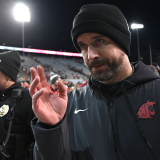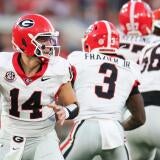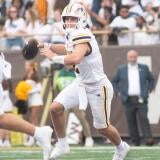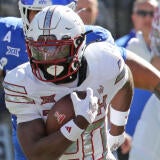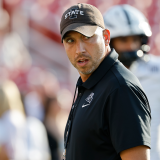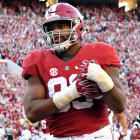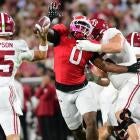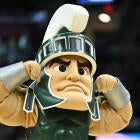Heisman Trophy voters must dramatically rethink how they view defensive players
It's ridiculous that Heismans almost always go to quarterbacks and running backs

It's time for Heisman Trophy voters to seriously consider defensive players. Correction: It's long past time for Heisman voters to seriously consider defensive players.
I'm not talking about a do-it-all defensive star like Michigan's Jabrill Peppers, who also touches the ball. Peppers has only gained voters' attention by returning punts and playing a little offense. That gives this freakish athlete at a brand-name and undefeated school the potential to produce one of those so-called "Heisman moments" with the ball in his hands.
No, I'm talking about opening your mind to think about voting in a much different way. I'm talking about the analytics community pushing out stats to show a more precise value of elite defensive linemen, linebackers and defensive backs. I'm talking about, as an example, identifying a candidate on Alabama's defense -- hello, Jonathan Allen -- since defensive touchdowns are a huge reason why the No. 1 Crimson Tide are so dominant.
To be clear: Louisville quarterback Lamar Jackson is understandably considered the frontrunner for the Heisman. You won't hear me argue against Jackson in this column. (You will hear me argue that the weekly Heisman race is silly until a larger body of work is available. But that's for another column.)
For the record, I'm not a Heisman voter, and I don't think voters are intentionally overlooking defense. There's a structural bias. Defensive players have gotten hurt for so long by the lack of readily available statistics detailing their value.
"It may take some time to get there, but it's moving in the right direction," said Steve Palazzolo, a writer for Pro Football Focus, which minds endless NFL and college data to find compelling information.
The reality is, the less a player touches the ball, the harder it is to win the Heisman. I get that. There's incredible value having the ball in your hand and impacting the game on offense.
Quarterbacks and running backs are named Heisman winners 94 percent of the time. That's similar to how often quarterbacks and running backs win the Associated Press NFL MVP award (95 percent). So this isn't just a college issue.
In MLB, 13 percent of the AL and NL MVP awards go to a pitcher. Of course, it's not a precise apples-to-apples comparison between pitchers and defensive football players. A pitcher touches the ball every time he's in the game, but unlike defensive football players, he sits out so many games. Still, baseball voters show a willingness to view their most outstanding players in different ways.
Over the past 10 years, nine defensive players finished in the top 10 voting for the Heisman. That's up from six between 1996-2005, when Michigan's Charles Woodson won the Heisman as a cornerback and returner. Still, you can't tell me that defensive players only deserve 5 percent of the Heisman votes for first, second and third place, as was the case in the past 10 years.
Football needs more widely accepted measurements of defensive players and a willingness to think differently. (By the way, I would also argue that better and more accessible stats and grades are needed for offensive linemen, too.) We shouldn't still be relying only on basic defensive stats -- tackles, interceptions, sacks, forced fumbles -- to evaluate players.
For example, Alabama leads the country in sacks and fewest rushing yards allowed. Seven Alabama defensive starters have scored a touchdown. Yet until Saturday, the only minimal amount of Heisman buzz around the Crimson Tide focused on quarterback Jalen Hurts, who was ranked by PFF as the 10th-best quarterback in the country last week.
Allen, Alabama's ridiculous 291-pound defensive lineman, has been one of the most dominant defensive players for two seasons. It's fair to say he's the best player on the best team in the country. PFF rates Allen as the No. 1 interior defensive lineman by a healthy margin.
Yet it took Allen making two amazing plays in a nationally-televised game -- a ridiculous flying sack of Texas A&M's Trevor Knight and a fumble return for a touchdown -- for some media members to finally suggest him for the Heisman. The reality is that, without radically rethinking the value of defensive players, Heisman talk for Allen will be fleeting.

If those two highlight plays hadn't been seen, Allen's stat line from the game -- six tackles, a sack, four other quarterback hurries -- would be met with All-America consideration, not Heisman love. Inevitably, Allen will encounter games when the offense game plans to avoid him, meaning fewer high-impact plays and no stats to measure how the attention placed on him benefits his teammates.
By studying video to chart stats, PFF is one of the few media outlets giving us a clearer picture of defensive players. To be fair, colleges could do a much better job of disseminating information, too. They have the coaches' film and could piece together more meaningful stats.
Last month, Palazzolo made a case for Texas A&M defensive end Myles Garrett -- the possible No. 1 NFL draft pick -- for the Heisman. At the time, PFF found that even with added attention by offenses, Garrett was pressuring the quarterback at a higher rate than his career average. Opposing quarterbacks had completed only 36 percent of their passes on plays in which Garrett created pressure, meaning he impacts the game even without making a sack.
"Using sacks as a gauge of the entire season does not do justice to the true value of a pass-rusher, particularly when the process of achieving the sack is far more important than just obtaining the statistic. Pressuring the quarterback in two seconds to force him into a teammate's sack or forcing a quick incompletion are more difficult to achieve than being on the opposite end and picking up the clean-up sack, and that's where we can better quantify Garrett's value."
PFF showed that Garrett won a "ridiculous" 12-of-24 head-to-head battles against UCLA left tackle Conor McDermott, a potential NFL draft pick. On those 24 plays, Garrett had a sack, three quarterback hits, six hurries and two other wins that didn't get recorded as pressure because the quarterback released the ball so quickly.
Consider the case of Peppers, who is being asked to play multiple defensive positions for Michigan. He's tied for 19th nationally in tackles for loss and third in punt returns. Those are stats we can tangibly see.
It's worth noting that Peppers wasn't on PFF's list for the Wolverines' five highest defensive grades against Illinois last Saturday. PFF grades Peppers as a safety, where he's No. 6 against the run nationally (he dropped from No. 2 after the Illinois game).
Still, it's silly that Peppers can only gather Heisman support by also playing offense and returning punts. It's the Charles Woodson Factor. Defensive players know that touching the ball is their only hope for the Heisman.
Here's Peppers, when he was a recruit in 2013, answering a question from ESPN about whether a defensive player can win the Heisman.
"Absolutely. [A defensive player is] going to have to have some punts and kickoff returns for TDs, six or seven picks and have more than 45 tackles. I have seen a lot of great defensive backs, but I didn't see anybody put it all together yet. Basically all the things I just said I have to do, and I want to make it a little easier on myself if I get to play a little offense, too."
Naturally, Michigan coach Jim Harbaugh should use Peppers on offense and punt returns if he believes doing so helps the Wolverines win games. (Newsflash: It does.) Peppers' versatility is what's helping his candidacy, but Harbaugh shouldn't have to put the ball in Peppers' hands and compare him to Jim Thorpe to sell Heisman voters on taking a serious look.
Football would be better off if an elite defensive player stood on his own as a real candidate for the Heisman. Why do college offenses continue to reach record numbers? The rules certainly benefit offenses. But it's worth wondering if all of the attention on offense causes some elite high high school players to bypass defense.
There's enough video now that we should be able to better quantify how often defensive players win or lose blocks, create pressure as pass rushers, make the tackles they should make, and win or lose in pass coverage.
We're not just cheating elite defensive players. We're cheating our audience, which is smart enough to know there's more value to terrific defensive players than we're telling them.
Given how good offenses are today, why wouldn't we place even more value on the defensive players who can stop the escalating scoring?
Why wouldn't we give more credit to Peppers, Allen, Garrett, Tennessee defensive end Derek Barnett, and other superb defensive players?
Why wouldn't we want to give defensive players a fighting chance to win the Heisman?



